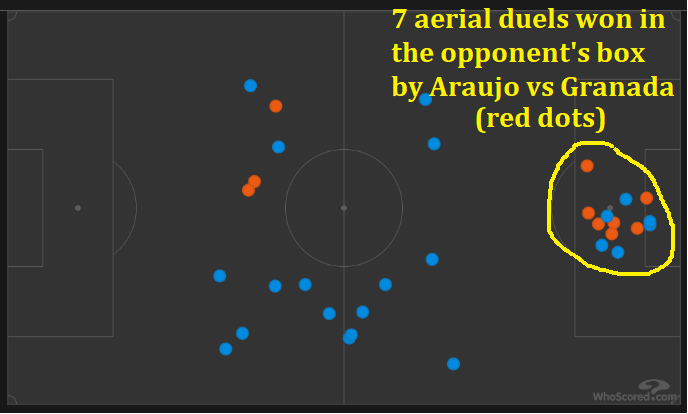About Crosses & Having a Plan B
54 Crosses in the Game vs Granada. What Went Wrong ? When & How is it OK to Cross ?
Some quick comments about crosses in general and the 54 ones made by Barça vs Granada in particular.
Note : Don’t get me wrong, crosses are a decent option. Nothing to be ashamed of. Some of the most important goals in the history of Barça came through crosses : See Bakero vs Kaiserslautern or Pizzi vs Atletico Madrid.
THE CROSSER
First, I felt most of the crosses were rushed. The wingers or full-backs not taking the time to lift their head to check how & if the spaces inside the box were correctly occupied. Also, they often crossed under pressure, before beating their marker, which prevented them from having a good passing angle. In these cases, it's better not to cross and rather recycle possession (pass back, switch to opposite side). Dest in particular was crossing from too wide, close to the sideline. Why not attempting a dribble or keeping possession instead of desperately crossing ?
In days like these, let's remember and value Alba's underrated capacity to always find free players in the box :
THE RECEIVERS
Crosses are like relationships : the 2 parties involved are responsible for making it work. Even more importantly, it needs coordination. Not only there has to be coordination between the crosser & the receiver, but the movements inside the box (the multiple potential receivers) have to be synchronized. In Barça’s case, none happened. Most players in the box were static and there was no rational occupation of spaces.
Usually, one player runs towards the 1st post, another towards the far post, while 1 or 2 midfielders rush into the box ready for the cutback… All of it while executing a diversity of movements to mislead the defenders : switch positions, drag a defender to create space for your teammate, or “come & go” (switch of direction) to lose your marker, etc…
As an example, see Suárez’ goal vs Rayo Vallecano (2015) : Munir goes from the 2nd to the 1st post, thus dragging a defender & creating space behind him. Suarez reads the play and goes from 1st to 2nd post. Neymar understands it & crosses towards that free space.
Apart from the lack of quality upfront, there’s also a lack of trickery. The only objective was to create a numerical superiority (the now infamous Triple 9) inside the box.

REHEARSED COMBINATIONS
Crosses are most interesting when preceded by combinations at the edge of the box. Guardiola’s Manchester City scored countless goals this way. Here’s the most common pattern : the right winger attracts some defenders wide before releasing the ball towards De Bruyne. This back pass is a trigger for the opponent’s block & defensive line to push forward, which creates a bit of space behind them. Then De Bruyne crosses from the right half-space targeting the space between defenders & goalkeeper.
When it is rehearsed & based on specific patterns, crosses do work!
Barça’s crosses, unfortunately, were not a thoughtful choice IMO. They were rather the consequence of their incapacity to reach any of the Assist Zones or Zone 14 (that’s where the passes/crosses carry most threat according to several statistical studies) through combinations. The lack of interior play meant the team’s passing followed a U shape and the advanced wide spaces were the closest they could get to Granada’s box.
INDIRECT EFFECTS
But let's not only consider the direct effect of a cross. Since it is more often than not cleared, the midfielders should be close enough to the box in order to fight for the 2nd ball or counter-press (see Man City’s sequence above). To allow this, the cross shouldn't be rushed. It should ideally come after a long spell of ball possession that provides the team with enough time to move up the pitch in a compact way.
But Barça’s crosses were rushed. The team block wasn’t positioned correctly and the clearances were often the starting point of Granada’s counter-attacks.
ONE LAST THING…
Araujo won 7 aerial duels in the opponent’s box after lateral crosses & set pieces. I always thought Barça’s defenders didn’t provide enough goals during a season (as Sergio Ramos or Thiago Silva would do for Real Madrid or Chelsea). So this is a positive.
CONCLUSION
From the 60th minute onwards, Barça played as if it was the 90th minute, packing the box and incessantly crossing the ball. This overemphasis led to crosses being delivered inaccurately or too early. Which made them predictable. Also, lateral crosses can be aerial, at ground level or mid-air. But out of Barça’s 54 crosses, 51 were aerial. Which made them even more predictable.
The lack of variety in attack was clear. When you have only 1 plan, it's harder to surprise the opponent : you need to activate other alternatives (set pieces, pre-planned combinations around the box, ground level crosses, cutbacks, counter-attacks…).
If you liked this post, consider subscribing. Or share it with other Culés & Football nerds & lets start a conversation. You can also follow me on Twitter & Youtube. Visca el Barça 💪🏾 🔵 🔴







Good analysis cap, thanks. I know this may be the case but its hard to believe that the team only strategy doesn't come from the training sessions, the team looked unprepared and not coached to play in this way. Appreciate your level headed analysis.